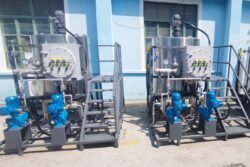
bioelectrochemical systems for wastewater treatment
Bioelectrochemical systems (BES) have gained significant attention in recent years as a sustainable and efficient technology for wastewater treatment. These systems leverage the metabolic processes of microorganisms to convert organic pollutants into clean water and valuable byproducts like electricity or hydrogen gas. This emerging field combines principles of microbiology, electrochemistry, and environmental engineering to provide a cost-effective and scalable solution for treating wastewater in a more environmentally friendly manner.
Introduction to Bioelectrochemical Systems
Bioelectrochemical systems are a type of microbial fuel cell (MFC) that uses microorganisms to catalyze electrochemical reactions. The key component of a BES is an electrode, typically made of carbon or other conductive materials, which serves as the electron acceptor for the microbial metabolism. As bacteria consume organic matter in the wastewater, they release electrons that flow to the electrode, generating a current that can be harvested as electricity.
There are two main types of bioelectrochemical systems: microbial fuel cells and microbial electrolysis cells. In a microbial fuel cell, microorganisms oxidize organic matter and produce electrons that flow to an anode, creating a current that can be used to power electrical devices. In a microbial electrolysis cell, a voltage is applied to the system to drive the reduction of water into hydrogen gas at the cathode. This allows for the production of hydrogen gas as a valuable byproduct that can be used as a clean energy source.
Advantages of Bioelectrochemical Systems for Wastewater Treatment
Bioelectrochemical systems offer several advantages over traditional wastewater treatment technologies, making them an attractive option for sustainable water management:
1. Energy generation: By harnessing the energy generated by microbial metabolism, BES can produce electricity or hydrogen gas that can be used to power the treatment plant or other processes. This can offset the energy costs of wastewater treatment and make the process more self-sustaining.
2. Enhanced treatment efficiency: BES can achieve higher removal efficiencies of pollutants compared to conventional treatment methods. The direct electron transfer from microorganisms to the electrode allows for faster degradation of organic matter and better control over the treatment process.
3. Resource recovery: BES can recover valuable byproducts such as hydrogen gas, methane, or organic acids from the wastewater, turning waste into a valuable resource. These byproducts can be used as energy sources, chemical feedstocks, or fertilizers, creating a circular economy approach to wastewater treatment.
4. Carbon footprint reduction: By harnessing renewable energy sources like solar or wind to power BES, the carbon footprint of wastewater treatment can be significantly reduced. This makes BES a more environmentally friendly solution for water management in a world facing increasing challenges from climate change.
5. Scalability and adaptability: BES can be easily scaled up or down depending on the size and needs of the wastewater treatment plant. They can also be integrated into existing treatment systems or combined with other technologies to improve overall efficiency.
Applications of Bioelectrochemical Systems in Wastewater Treatment
Bioelectrochemical systems have been successfully applied to a wide range of wastewater treatment applications, including:
1. Municipal wastewater treatment: BES can be used to treat municipal wastewater from households and industries, removing organic pollutants and producing clean water for discharge or reuse. This can help cities and towns meet regulatory requirements for water quality while reducing the environmental impact of wastewater treatment.
2. Industrial wastewater treatment: BES can also be used to treat industrial wastewater from manufacturing plants, refineries, and other industries. These systems can handle a wide range of pollutants and contaminants, providing a cost-effective and sustainable solution for treating complex wastewater streams.
3. Agricultural wastewater treatment: BES can be used to treat agricultural wastewater from livestock operations, crop irrigation, and food processing facilities. By removing organic matter and nutrients from the wastewater, BES can help reduce nutrient pollution in water bodies and protect aquatic ecosystems.
4. Remote or off-grid wastewater treatment: BES can be a viable option for treating wastewater in remote or off-grid locations where access to traditional treatment facilities is limited. By generating electricity or hydrogen gas on-site, BES can provide a self-sustaining solution for wastewater treatment in these areas.
Challenges and Future Directions
Despite the many advantages of bioelectrochemical systems for wastewater treatment, there are still some challenges that need to be addressed to enable wider adoption and commercialization of this technology:
1. Performance optimization: Research is ongoing to improve the performance of BES in terms of treatment efficiency, energy generation, and system stability. This includes optimizing microbial communities, electrode materials, and operating conditions to maximize the overall performance of the system.
2. Scale-up and cost reduction: Scaling up BES from lab-scale to real-world applications can be challenging due to the complexity of the system and cost constraints. Research is needed to develop cost-effective and scalable BES designs that can be easily implemented in commercial wastewater treatment plants.
3. Long-term operation and maintenance: Maintaining stable operation of BES over the long term is critical for its successful implementation in wastewater treatment. Regular monitoring, cleaning, and maintenance of the system are necessary to ensure its optimal performance and longevity.
4. Regulatory approval and public acceptance: As with any new technology, regulatory approval and public acceptance are key factors for the widespread adoption of BES in wastewater treatment. Continued collaboration between researchers, industry partners, and regulatory agencies is needed to address any concerns and ensure the safe and effective implementation of BES in water management.
Looking ahead, the future of bioelectrochemical systems for wastewater treatment looks promising as researchers continue to innovate and improve the technology. With ongoing advancements in materials science, microbiology, and electrochemistry, BES has the potential to revolutionize the way we treat wastewater and manage water resources in a more sustainable and environmentally friendly manner. By harnessing the power of microorganisms and renewable energy sources, BES can help us create a cleaner and greener world for future generations.
